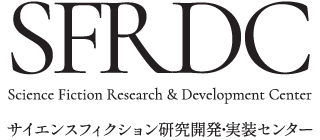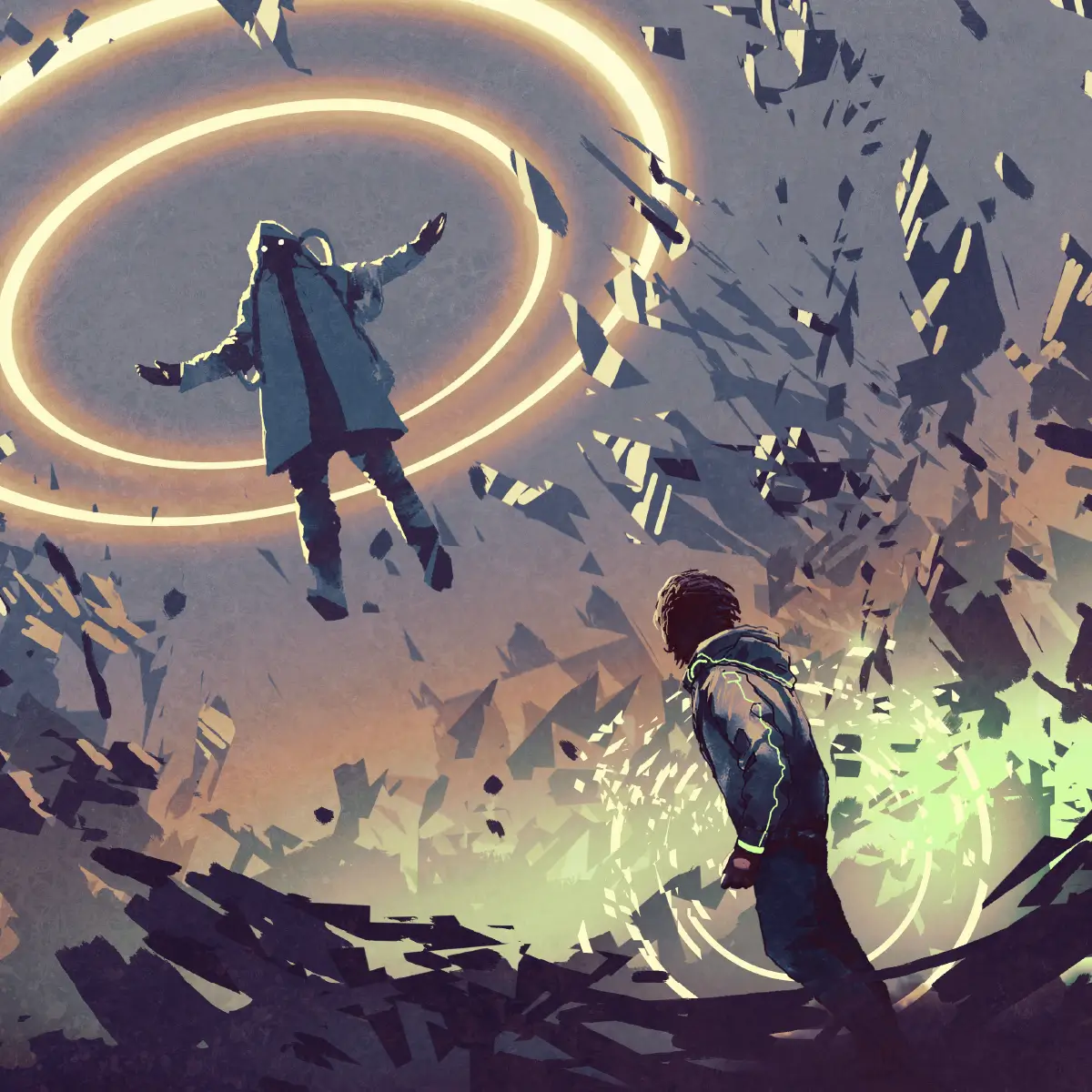Outline研究について
本研究センターはアート・創作におけるSFの歴史とその変革を踏まえ、文学、工学、アートの研究者が共同で物語の価値を探索し、人類社会のイノベーションにつなげるための方法論としてのSFのあり方を探求する。本研究センターの目標は以下の4点である。- SFを中心とした物語の仕組みに関する文学・工学・美学横断的な研究
SFがもたらした影響を認知科学や美学、文学、アートの観点からそれぞれ議論する。本領域ではこれらの領域に関わる研究活動を、紀要を通じてまとめ、発表する。 - 情報技術等を用いた創造性支援技術の開発
主に情報技術、人工知能技術を用いた創造性支援に関する開発を行う。本事業ではクリエイターと研究者の共同参画を支援し、人工知能技術を通じた未来の創作のあり方を探る。 - SFプロトタイピングを用いた人々の創造性支援手法の普及
SFやSFプロトタイピングを用いた人々の教育支援を行う。本活動はSFプロトタイピングやスペキュラティブデザインなどのプロジェクトの実施、SFプロトタイピングを実施する企業へのアドバイザー活動を行う。また、これにより共同研究などを進める。 - SF研究開発に基づく知財の申請と出版・イベントの開催
SFセンターの研究開発によって生まれた特許技術等の申請と出版・イベントを通じた普及

Purpose目的
生成AIのような創作補助技術により、創作のあり方はより民主化され、同時にSFプロトタイピングのように専門家をつなぐための物語のあり方が問われる世の中となった。特にSFは歴史的に、科学技術の普及の媒体であるとともに、社会の多様性を促進し、イノベーションの創発を産んだジャンルでもあり、文学研究、科学技術研究、アートなど多分野に影響を与える軸となる領域である。人間の作家の自己表現としての創作が絶えることはなく、また、創作を通じて他者の表現意図を知るという、コミュニケーションの手段としての創作もまた、途絶えることはないと考えらえる。これは生成 AI の前から、人口減に伴う出版産業などの縮小が契機となっており、作家が多方面に活躍する手法を探していることが要因である。
この一つとして SF プロトタイピングがある。SF プロトタイピングでは、作家が研究者や開発者と共同で議論を行い、未来のビジョンを共同で物語として執筆し、それを元に企業や社会のビジョンを考察する。単純に創作物を鑑賞し、そこからイノベーションを探すのではなく、創作過程を通じて、参加者の想像力を養い、発想支援に役立てる手法である。これは日本に限った話ではない。米国では科学技術やアートの教育プログラム(STEAM)の一環として、物語の使用が行われている。また、今年アジアで横浜に次ぐ 2 回目の世界 SF 大会を開催した中国では、創作のもつ教育的側面が大きく重視されており、国家の支援を受けた出版社が教育プログラムを開き、作家が教育機関で指導を行い、SF を児童が執筆する過程を通じて科学技術に親しむ枠組みを作る、といった取り組みが行われている。SF は発想支援の分野において先進的な機能を担うことが多い。SF プロトタイピングに関する提案者の研究や、それ以外の研究およびムーブメントの動きからいくつか利点が判明してきている。まず、SF を用いることで思考の枠を外しやすくなることが挙げられる。これは SF が科学技術を扱うためで親和性が高いのと同時に、文学的にはSF が個人の文学ではなく、制度の文学であり、個人の価値観を超えた環境や社会の変革に伴うドラマを想定しやすいことが挙げられる。同時に、スペキュラティブフィクションと呼ばれるような、価値観の変革を伴う思考的な実験を SF が促進するメリットもある。これは現在マイノリティの属性を持つ人々にとって、心理的安全性を保ったまま意見を言いやすくなる利点がある。
こうした状況を踏まえ、本研究センターではSFにおけるイノベーション共創の側面に着目し、文学・工学・アートを横断した研究を行う。
Research Divisions研究グループ
センターは以下の6グループに分かれて研究を行っています。
The center conducts research in the following six groups:
History沿革
- 2025年4月
- 本センターとして正式稼働開始。
- 2024年1月
- 慶應義塾大学グローバルリサーチインスティテュート(KGRI)内にスタートアップセンターとして設置。
Sponsorsスポンサー / 協力 / 後援
- 慶應義塾大学 グローバルリサーチインスティテュート
- 慶應義塾大学生成AIラボ 想像力・社会知能AIユニット
- 慶應義塾大学理工学部管理工学科 ヒューマンエージェントインタラクション研究室
- 公益財団法人トヨタ財団 先端技術と共創する新たな人間社会 「人工知能と虚構の科学」D22-ST-0030
- JSPS 学術知共創プログラム「ポストヒューマン社会のための想像学」JPJS00124017859
- ムーンショット型研究開発事業 目標1 身体的共創を生み出すサイバネティック・アバター技術と社会基盤の開発「デザインフィクションを用いたサイバネティック・アバター社会の探索」JPMJMS2013
- 石井・石橋基金 慶應義塾大学若手研究者育成ものづくり特別事業「鏡像世界の構築から広がるマルチバース創成」
- JSPS 学術変革領域研究(A) 「生涯学の創出-超高齢社会における発達・加齢観の刷新」公募研究 『サイエンス・フィクションが示唆する未来の発達・加齢観の分析』 (2022.4-2024.3) JP23H03896
- 慶應義塾大学理工学部・理工学研究科「若手研究者国際シンポジウム・会議主宰支援制度」 (2025.6-2025.9)
Outline
This research center explores the value of narratives through collaboration among researchers in literature, engineering, and art, drawing on the history and transformations of science fiction (SF) in art and creativity. It seeks to define SF as a methodology for driving innovation in human society. The center's objectives are as follows:- Interdisciplinary research across literature, engineering, and aesthetics on the mechanisms of storytelling centered on SF
Discuss the impact SF has brought from the perspectives of cognitive science, aesthetics, literature, and art. This domain will compile and publish research activities related to these fields through its journal. - Development of creativity support technologies using information technology, etc.
Primarily develop creativity support technologies using information technology and artificial intelligence. This project supports collaborative participation between creators and researchers to explore future creative practices through AI technology. - Promoting methods for supporting human creativity using SF prototyping
Provide educational support for individuals using SF and SF prototyping. This activity involves implementing projects such as SF prototyping and speculative design, and providing advisory services to companies conducting SF prototyping. It also advances collaborative research and other initiatives. - Intellectual Property Applications and Publication/Event Organization Based on SF R&D
Application for patent technologies and other intellectual property born from SF Center R&D, and dissemination through publications and events.

Purpose
Creative assistance technologies like generative AI have democratized the act of creation. Simultaneously, we now live in an era where the role of narrative—such as in science fiction prototyping—in connecting experts is being questioned. Historically, science fiction has served as a medium for disseminating science and technology, while also promoting social diversity and fostering innovation. It remains a pivotal field influencing literature, science and technology studies, art, and numerous other disciplines. Human authors' creative expression as self-expression will never cease. Likewise, creation as a means of communication—understanding others' expressive intent through creative works—is also unlikely to disappear. This trend predates generative AI, driven by factors like the shrinking publishing industry due to population decline, prompting authors to seek diverse avenues for their work.
One such avenue is SF Prototyping. In SF Prototyping, writers collaborate with researchers and developers to discuss and co-author narratives depicting future visions. These stories then serve as a basis for examining corporate and societal visions. Rather than simply appreciating creative works to seek innovation, this method cultivates participants' imagination and supports idea generation through the creative process itself. This is not unique to Japan. In the US, storytelling is used as part of science, technology, engineering, arts, and mathematics (STEAM) education programs. Furthermore, in China, which hosted the second World Science Fiction Convention in Asia this year following Yokohama, the educational aspects of creative work are highly valued. Initiatives include state-supported publishers launching educational programs, authors providing instruction at educational institutions, and creating frameworks where children write science fiction to foster familiarity with science and technology. Science fiction often plays a pioneering role in the field of idea generation support. Several advantages have emerged from the proponent's research on SF prototyping, as well as other studies and movements. First, SF facilitates breaking out of conventional thinking frameworks. This stems from SF's inherent affinity with science and technology, combined with its literary nature as institutional rather than personal literature, making it easier to envision dramas involving environmental and societal transformations beyond individual values. Simultaneously, SF promotes what is termed speculative fiction—thought experiments involving shifts in values. This offers the benefit of enabling individuals with currently minority attributes to express opinions more easily while maintaining psychological safety.
Given this context, this research center focuses on the aspect of co-creation of innovation within SF, conducting research that crosses the boundaries of literature, engineering, and art.
Research Divisions研究グループ
センターは以下の6グループに分かれて研究を行っています。
The center conducts research in the following six groups:
History
- April 2025
- Center officially commenced operations.
- January 2024
- Established as a startup center within the Keio University Global Research Institute (KGRI).
SponsorsSponsors / Collaborators / Supporters
- Keio University Global Research Institute
- Keio University Human-Centered AI Lab Imagination & Social Intelligence AI Unit
- Keio University, Faculty of Science and Technology, Department of Management Engineering, Human-Agent Interaction Laboratory
- Toyota Foundation: New Human Society Co-Created with Advanced Technology “Artificial Intelligence and the Science of Fiction” D22-ST-0030
- JSPS Academic Knowledge Co-creation Program “Imagination Studies for a Post-Human Society” JPJS00124017859
- Moonshot R&D Project Goal 1: Development of Cybernetic Avatar Technology and Social Infrastructure for Physical Co-Creation “Exploring Cybernetic Avatar Society Using Design Fiction” JPMJMS2013
- Ishii-Ishibashi Fund Keio University Young Researcher Development Special Project “Creating Multiverses from Constructing Mirror Worlds”
- JSPS “Analysis of Future Development and Aging Perspectives Suggested by Science Fiction” (Apr 2022 – Mar 2024) JP23H03896
- Keio University Faculty of Science and Technology / Graduate School of Science and Technology “Support Program for Young Researchers Hosting International Symposiums and Conferences” (Jun 2025 - Sep 2025)






